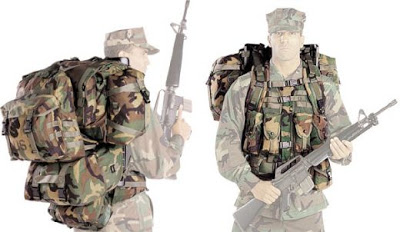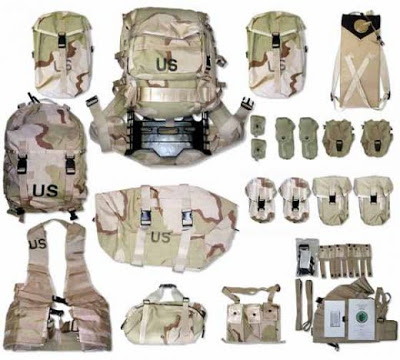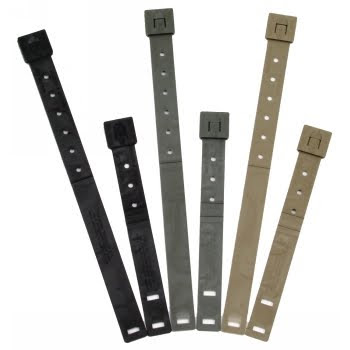
Mindful that there is a ton of current issue MOLLE (pronounced "Molly") gear out there now, I provide this quick primer stolen from various sources. Because it is newer stuff, it is not covered in FM 21-15. Here is an overview from hubpages.com.
http://hubpages.com/hub/MOLLE
MOLLE
By Xim
MOLLE: Modular Lightweight Load-carrying Equipment
MOLLE or MOdular Lightweight Load-carrying Equipment is the current incarnation of carrying equipemnt in use by the U.S. Army. It replaces the ALICE pack system that was used since the Viet Nam war.
The MOLLE system is worn rather than carried and allows for complete customization for improved mission efficiency without compromising mobility or readiness. The MOLLE system uses an external frame with a quick release mechanism that allows the soldier to drop the carrying gear while still maintaining the fighting load carrying vest & pockets.
MOLLE Equipment
In 1994 when the U. S. Army had difficulties adapting the ALICE pack to desert warfare in the first Gulf War (in 1991) they started to redevelop a load carrying system that would be modular, durable, and comfortable.
They undertook biomedical studies to determine the most efficient way to carry loads. They studied the effects of load carrying and human performance. They looked at energy cost, the preferred walking posture, volume configuration, and load center implications under a variety of field requirements. The result was completely new equipment called Modular Lightrweight Load Carrying Equipment, designated as MOLLE. The MOLLE system is a much more advanced and comfortable carrying system.
MOLLE features a load bearing vest with butt pack. It will accommodate a main ruck with pouches and a sleeping bag compartment attached to an external frame. The vest does have a built-in belt, but the vest replaces the web belt and suspenders of the ALICE system. At first there was little use for the MOLLE, but when troops were deployed into Afghanistan in late 2001 and 2002 and to Iraq in 2003, field experience led to a number of improvements including these. The external plastic frame had to be strengthened. Zippers that burst when overloaded had to be improved. The straps on the pack had to be lengthened to accommodate body armor.
The nylon mesh vest can accommodate different carrying needs of individual soldiers. Removable pockets can permit each member of the squad to carry different loads. Hence, a rifleman, a grenadier, an automatic weapon operator, and other specialists can have a MOLLE conveniently customized to their needs. The vest can be chosen to fit the body size and build of the wearer. More weight is at the shoulders and hips and during a long march soldiers can shift the weight to minimize discomfort.
The MOLLE vest has no metal clips or hooks that can be awkward and dig into the skin. It has an H harness in the back to minimize heat buildup. However, the “ball & socket” interface between the frame and the rucksack belt led to numerous lower back injuries and had to be eliminated.
Being used in desert operations, the woodland pattern of coloring was replaced by the digital Universal Camouflage Pattern to match the Army Combat Uniform. All these and other changes have been introduced during the past five years in Iraq and Afghanistan.

This pdf from BAE Systems, one of the manufacturers of MOLLE, will help you identify current MOLLE gear equipment --
http://www.baesystems.com/BAEProd/groups/public/documents/bae_publication/bae_pdf_mps_indv_molle.pdf
Those who wish to adapt ALICE pouches to MOLLE gear may do so by using Tactical Tailor's MALICE clips, found here: http://www.tacticaltailor.com/maliceclip.aspx
MALICE CLIPS® are injection molded, heavy duty, reusable connecting clips that are designed to attach modular pouches to MOLLE/PALS style equipment. MALICE CLIPS® are not affected by heat or cold, and will never corrode or lose their subdued finish. Once properly closed, the clip will not open until it is disengaged by the user using a flat tipped object such as a knife or screwdriver. Available in Black, Tan and Foliage Green(ACU).
 MALICE CLIPS
MALICE CLIPSAnd these cleaning instructions are from the Army's PS magazine:
Bubble bath for MOLLE
PS: The Preventive Maintenance Monthly, April, 2007
Some parts are water-resistant nylon. Others are rugged plastic. It makes no difference. Sooner or later every part of your modular lightweight load-carrying equipment (MOLLE) gets covered with dirt, mud and grime. That means it's time for a cleaning.
A bath for MOLLE every once in a while helps the parts work better and last longer. Regular cleaning also makes MOLLE more comfortable to wear.
HERE'S THE RIGHT WAY TO CLEAN...
* Brush off caked-on or dried-in dirt with your hands. Or scrape it off with a flat stick or dull tool. Never use anything sharp that will cut the fabric or webbing. After you scrape off the heavy stuff, wipe away the loose dirt with a soft brush or clean cloth.
Brush off caked-on dirt
* Wash MOLLE by hand in a bucket of warm, soapy water. NSN 7930-00-929-1221 brings a mild detergent that cleans well even in hard or salty water.
Wash in warm, soapy water
* If there are still some stubborn, soiled spots that haven't washed out, scrub them with a white or colorfast cloth. Then dip the problem areas in the soapy water again.
* After washing, rinse thoroughly in clean, warm water. Remove all traces of soap. Then stretch the fabric back to its original shape.
* Air-dry in the shade or indoors. Never use a clothes dryer. That'll not only shrink MOLLE, but also expose it to unnecessary wear and tear. And don't dry MOLLE in direct sunlight or near a heater or open flames--they'll fade and shrink the fabric.
NEVER PUT MOLLE IN A WASHING MACHINE.
AVOID THE USE OF CHLORINE BLEACH YELLOW SOAP, CLEANING FLUIDS AND SOLVENTS.
THEY WILL DISCOLOR MOLLE AND BREAK DOWN THE FABRIC.
DRY IN THE SHADE TO PREVENT FADING AND SHRINKING!
1 comment:
FM 21-15 is at http://www.sendspace.com/file/mn352y
Sorry - there are ads but it's a no-reg download...
HTH...
Post a Comment